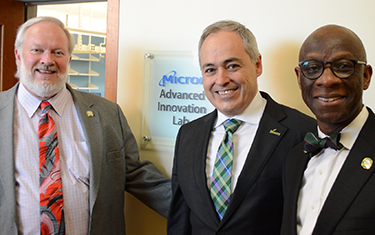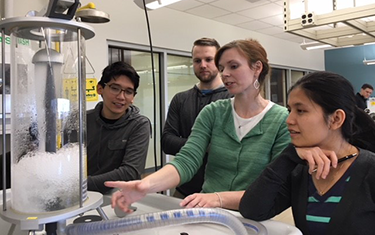The university “is positioning the SciTech Campus for major growth by investing in collaborative research and instructional space."
Provost S. David Wu

Mason Engineering Dean Ken Ball (left), Mason President Ángel Cabrera, and Mechanical Engineering Chairman Oscar Barton tour the new Micron Advanced Innovation Lab at Bull Run Hall on the Science and Technology Campus.
President Ángel Cabrera and other George Mason University officials explored the newly renovated mechanical engineering labs during a Friday visit to Bull Run Hall on the Science and Technology Campus.
About 3,600 square feet of existing space in the building was converted into a state-of-the art collaborative classroom, a lab dedicated to studying fluid dynamics and heat transfer, and a lab for studying materials science and engineering. The latter is named the Micron Advanced Innovation Lab after its sponsor.
The renovated space, which has a project budget of $1.6 million, opened for classes in the fall. “The completion of these labs and collaborative learning spaces is a vital part of our strategic planning to build a presence for mechanical engineering at the SciTech Campus,” says Mason Engineering Dean Ken Ball.
Provost S. David Wu says the university “is positioning the SciTech Campus for major growth by investing in collaborative research and instructional space. We want to leverage our physical assets in the most effective, efficient way, better aligning our needs in science, engineering, and other programmatic demands with appropriate infrastructure and resources. The mechanical engineering labs are the beginning of this effort.”
Mason offered three junior-level mechanical engineering courses at SciTech in the fall and spring semesters. Next year, students can select from six junior-level mechanical engineeering courses. More classes will be rolled out in the next few years.
“Students have a sense of pride in the new space,” says Mechanical Engineering Department Chairman Oscar Barton.

Students are working in the new fluid dynamics and heat transfer lab at the SciTech Campus. Pictured here: Esteban Perez (left), Luke Jameson, lab instructor Elisabeth Lattanzi, and Wint Zaw.
Elisabeth Lattanzi, the lab manager and instructor, agrees. “Our students are lucky to have state-of-the-art spaces and equipment to complement the theories they’ve learned in other courses.”
While on the tour of Bull Run Hall, Cabrera met students doing research in nanomedicine, biomaterials, biodefense, metabolomics, and concussion prevention.
Engineering students enjoy a rich multidisciplinary environment at SciTech with other faculty from chemistry, biochemistry, systems biology, and sports medicine, says Bioengineering Department Chairman Michael Buschmann. “The ability to bring together these disciplines is very motivating and an exciting opportunity for them to translate discoveries to medical applications.”
The officials also visited lab space that’s currently being renovated. This includes a future clean room, which will be used by researchers who need to work in a controlled space with a low level of environmental pollutants, such as dust, airborne microbes, aerosol particles, and chemical vapors, says Colby Grant, operations coordinator for SciTech.
Other improvements are in the works. By April, Mason Engineering and College of Science faculty and students are expected to have access to renovated lab space on the third floor for the Institute for Advanced Biomedical Research.
The university is also planning a 100,000-square-foot addition to Bull Run Hall for the engineering school and other departments.
The completion of these labs and collaborative learning spaces is a vital part of our strategic planning to build a presence for mechanical engineering at the SciTech Campus.
Mason Engineering Dean Ken Ball
